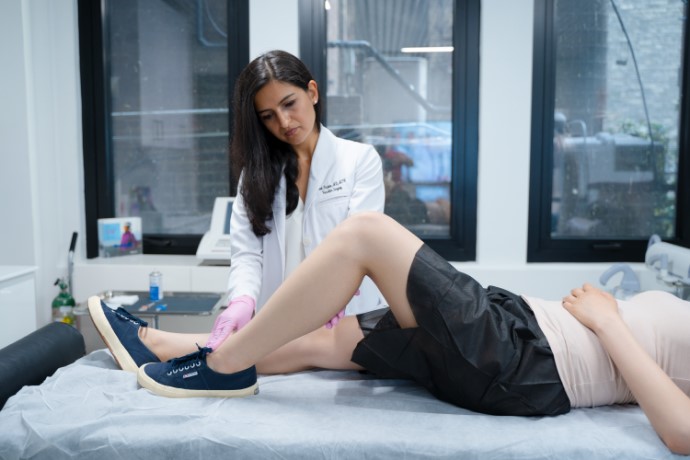Understanding insurance coverage for Are varicose veins covered by insurance? can be complex. Insurance plans differ significantly in what they cover, making it crucial to understand how your policy handles treatments for varicose veins. This article will delve into the various factors affecting insurance coverage for varicose veins and provide practical insights to help you navigate your options.
Table of Contents
What Are Varicose Veins?
Varicose veins are swollen, twisted veins visible just under the skin, often appearing on the legs. They occur when valves inside the veins fail, causing blood to pool and the veins to enlarge. While often considered a cosmetic issue, varicose veins can lead to discomfort, pain, and more serious health problems if left untreated.
Why Is Treatment for Varicose Veins Necessary?
Treatment for varicose veins is not solely for cosmetic reasons. Many individuals experience pain, swelling, and other symptoms that affect their quality of life. In some cases, untreated varicose veins can lead to complications such as ulcers or blood clots. Therefore, addressing varicose veins through treatment is not only about aesthetics but also about maintaining overall health and preventing future complications.
Types of Treatments for Varicose Veins
Understanding the different treatments available can help you determine whether your insurance might cover them. Here are some common treatments:
- Sclerotherapy: This involves injecting a solution into the affected veins, causing them to collapse and fade over time. It’s typically used for smaller varicose veins and spider veins.
- Laser Therapy: This treatment uses laser light to heat and damage the vein, causing it to collapse and be absorbed by the body.
- Endovenous Laser Therapy (EVLT): A more advanced laser treatment that involves inserting a laser fiber into the vein through a catheter to close it off from within.
- Radiofrequency Ablation (RFA): Similar to EVLT, this method uses radiofrequency energy to heat and close off the vein.
- Vein Stripping: This surgical procedure involves removing the affected veins through small incisions. It’s typically reserved for more severe cases.
- Ambulatory Phlebectomy: This technique involves removing small varicose veins through tiny incisions in the skin.
What Factors Affect Insurance Coverage for Varicose Veins?
Several factors influence whether insurance will cover varicose vein treatments:
- Medical Necessity: Insurance companies are more likely to cover treatments deemed medically necessary rather than purely cosmetic procedures. If you can demonstrate that your varicose veins are causing significant symptoms or complications, your insurance may be more inclined to provide coverage.
- Insurance Plan Details: Coverage varies widely between insurance plans. Some plans may cover certain treatments while excluding others. Reviewing your specific policy details or contacting your insurance provider can clarify what is included.
- Pre-Authorization Requirements: Many insurance companies require pre-authorization for varicose vein treatments. This means you may need to get approval from your insurer before undergoing treatment. This step ensures that the treatment is covered under your policy.
- Provider Network: Treatments performed by in-network providers are more likely to be covered by insurance compared to those done by out-of-network providers. Ensure that your chosen healthcare provider is within your insurance network to maximize coverage.
How to Determine If Your Insurance Covers Varicose Vein Treatments
To determine whether your insurance covers varicose vein treatments, follow these steps:
- Review Your Policy: Start by reading your insurance policy documents. Look for sections related to vein treatments, medical necessity, and cosmetic procedures.
- Contact Your Insurance Provider: Reach out to your insurance company directly. Ask about coverage for specific treatments, the process for pre-authorization, and any out-of-pocket costs you might incur.
- Consult Your Healthcare Provider: Your doctor or specialist can often assist with insurance matters. They may help with documentation or provide information on which treatments are considered medically necessary.
- Request a Pre-Authorization: If required, submit a request for pre-authorization to ensure that your treatment is covered. This process involves providing detailed medical information to justify the need for the procedure.
- Keep Records: Maintain detailed records of all communications with your insurance company and healthcare provider. This includes policy details, pre-authorization approvals, and any correspondence related to coverage.
Common Insurance Coverage Scenarios
Understanding common scenarios can help you anticipate how your insurance might handle coverage:
- Full Coverage: Some insurance plans fully cover medically necessary treatments for varicose veins, including sclerotherapy, laser therapy, and surgical options.
- Partial Coverage: Insurance may cover a portion of the costs, leaving you responsible for copayments or deductibles. In this case, check if the coverage includes specific treatments or providers.
- No Coverage: Certain insurance plans might exclude coverage for all varicose vein treatments, categorizing them as cosmetic procedures. If this is the case, you may need to explore alternative payment options.
Financial Assistance and Payment Options
If your insurance does not cover varicose vein treatments, consider these options:
- Flexible Spending Accounts (FSAs) or Health Savings Accounts (HSAs): These accounts allow you to use pre-tax dollars for medical expenses, potentially covering treatments not included in your insurance plan.
- Payment Plans: Some healthcare providers offer payment plans or financing options to help manage the cost of treatment.
- Medical Credit Cards: Specialized credit cards for medical expenses can provide a way to pay for treatments over time.
Conclusion
Navigating insurance coverage for varicose veins involves understanding your policy, determining medical necessity, and exploring all available options. By reviewing your insurance documents, consulting with your provider, and considering alternative payment methods, you can better manage the costs associated with treating varicose veins. Always stay informed and proactive to ensure that you receive the necessary treatment without unnecessary financial strain.

